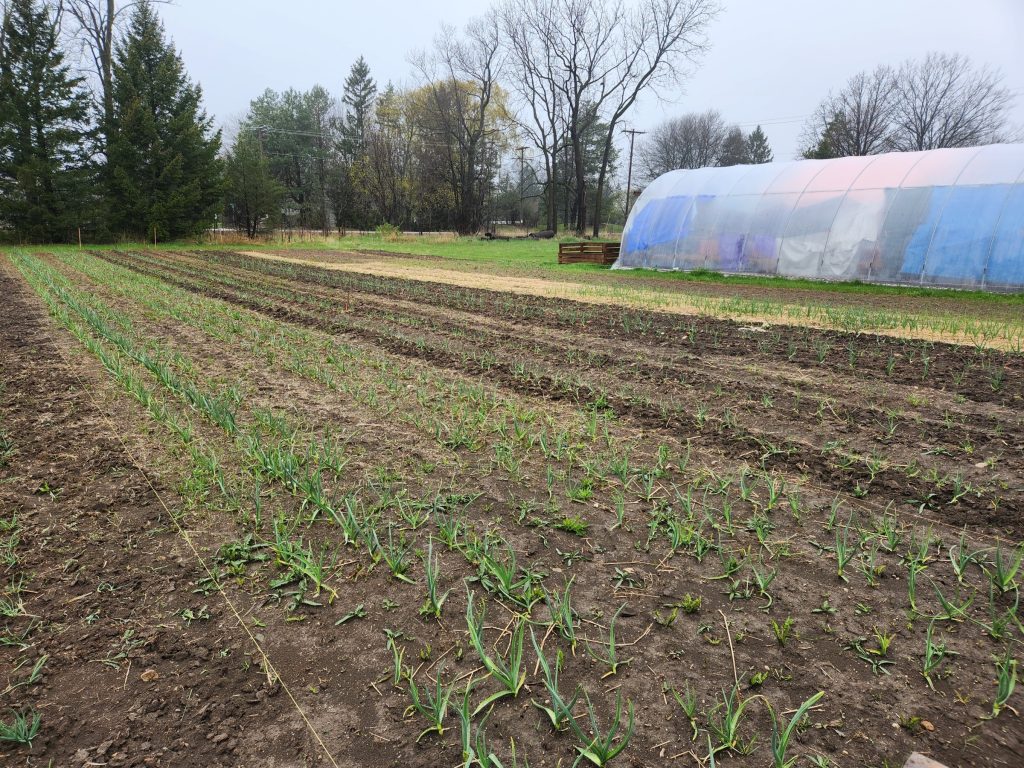Weather and climate conditions this week in Wisconsin
Here are this month’s take-home points about the weather. Scroll down for the full downloadable report.

Current Wisconsin weather and climate conditions
- Most in the state received less than an inch of precipitation last week, with localized areas of 2+” in Dane County. Lesser totals in the north where it has been wetter in past weeks.
- Temperatures were seasonal, near to average across the state. Highs topped 80ᵒF for many in the south on April 29th.
Impact
- Soil moisture conditions that are wetter-than-average are common across the north/central but continue to remain dry in the southeast. However, more of the south is now in near-normal conditions.
- >97% of the state is drought-free, with the remining D1 coverage in the far SW.
- Corn and soybean planting made big gains from last week (16% & 17% complete, respectively; Source: NASS).
- Wisconet soil temperature readings at 4” are at or above 50ᵒF across the entire state
Outlook for Wisconsin weather and climate
- Frost/freeze risk is still existent across the state, but the risk is slim outside of the north & central. Check this link for day-to-day freeze chances from NWS Milwaukee.
- Things look fairly quiet for precipitation this week, with the best chances for precipitation in the NW and WC.
- Mid-May is showing a lean towards warmer- and wetter-than-normal.
- Probabilities for May are showing a lean towards warmer and drier.
Agronomic considerations
- Field Work and Conditions
- Soil temperatures and conditions are favorable for planting in the southern part of the state. Northern areas still have a frost risk this week.
- Avoid trafficking fields in moist conditions to prevent compaction and rutting.
- Consider preplant nitrate tests to assess nitrate levels before fertilizing.
- Avoid fertilizer applications in wet and cool conditions. Nitrogen loss is greater in wet conditions.
- In drier regions of the state, consider earlier termination of cover crops to retain soil moisture if conditions remain dry. If conditions are wet, consider delaying termination to manage excess soil moisture.
- Manure Applications
- Reminder of Wisconsin’s NR 151 Runoff Rules with the timing of manure spreading and current runoff levels. Check DATCP Runoff Risk Advisory Forecast.
- Pest Management
- Start scouting fields by foot to note any early emerging weeds.
- Ensure temperatures (day, night, and soil) are conducive for herbicide applications. Pre-emergent herbicides require moisture for activation.
- Be observant of black cutworm and true armyworm moths migrating to the state. Check trap catches in your region with the DATCP Pest Survey.
- Forage Management
- Southern to central regions of the state have reached 300 GDD for alfalfa which is the time to begin scouting for alfalfa weevil.
- Alfalfa stands in southern WI are rapidly growing. Watch for lodging if plants reach tall heights before first harvest. See first harvest considerations here.
- Small Grains
- Revisit small grain fertility needs.
- Reminder to properly stage small grains such as winter wheat, as many herbicides cannot be applied after Feekes 5.
- Specialty crops- Vegetables
- Adult seed corn maggot flies, which affect a range of vegetable crops, have emerged in southern Wisconsin. These pests overwinter in Wisconsin as pupae in the soil. When the flies emerge, they are attracted to fields with high organic matter. If possible, terminate and incorporate cover crops 2-3 weeks before planting to reduce the attractiveness of these fields as egg laying sites. Delaying direct seeding until soil is warmer will reduce the risk of seedling damage. Also be aware of similar risks from cabbage and onion maggot flies, which emerge later in the season.
- Common asparagus beetle populations will reach damaging levels in southern Wisconsin in the next 2-3 weeks. Scouting should occur in the afternoon when these beetles are most active
- Start scouting for black cutworm migrating to the state with weather fronts. Check trap catches in your region with the DATCP pest survey.
- Reference the Vegetable Disease and Insect Forecasting Network (VDIFN) to know what diseases and insects to be scouting for in your area.
- Specialty Crops- Fruit
- Apple growers can reference the NEWA weather station network to monitor disease infection events. Make sure to keep track of green tip and petal fall dates. Check out your nearest weather station: NEWA Weather Station Network (Cornell).
- Wisconsin fruit growers can reference the Midwest Fruit Pest Management Guide for a list of registered products and recommended best practices. View the MFPMG Online or order a hard copy here: MFPMG Hard Copy.
- Reminder: Do not use insecticides or miticides during bloom to protect pollinators.
- Growers may consider visually scouting for mites and aphids. Use a hand lens to ID mites and check the undersides of leaves for aphids. Watch for curled, wrinkled, bronzed or stunted leaves.
- Growers may consider visually scouting for lepidopteran larvae feeding on young leaf material and/or hanging pheromone monitoring traps.
- Growers with historic populations of plum curculio or tarnished plant bug may consider monitoring orchard perimeters and/or hanging monitoring traps.
If you would like to obtain a PowerPoint copy of this report, please email rue.genger@wisc.edu.




